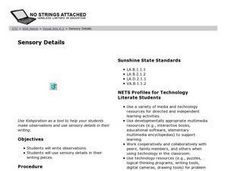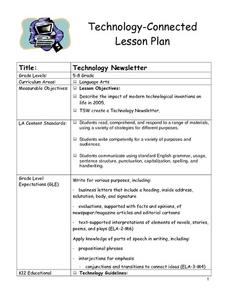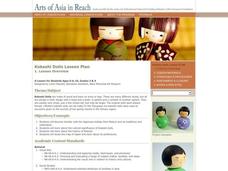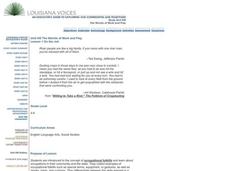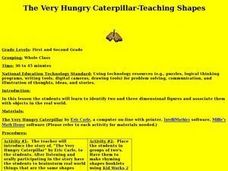Curated OER
Do Plants Need Water?
First graders observe the effects of varying amounts of water, sun, and air on lima bean plants. They also predict and describe their outcomes in a written report.
Curated OER
Interactive Journeys
Learners investigate environments and animals through the use of technology while on class field trips. The lesson is highly adaptable and can work with any field trip in many subject areas.
Curated OER
Sensory Details
Students observe their environment and write detailed, sensory-specific sentences about that environment. This activity can be extended to include the creation of a personalized story or movie of the experience (student examples are...
Curated OER
Patterns
Students extend, generalize, recognize, and write a variety of patterns using an AppleWorks template and the Inspiration or Kidspiration educational software. This technology-based math lesson is intended for the early elementary classroom.
Curated OER
Fact Families
Students create "fact families" using digital pictures of their classmates and knowledge of basic math concepts (subtraction and addition) in this technology-based math instructional activity intended for use in the early-elementary...
Curated OER
Fast Food Survey Using Bar Graphs
Second graders create a bar graph to pictorically represent the data collected from a survey of students. They use Excel to electronically create the graphs and data tallies. They then interpret their data using sentences to explain.
Curated OER
Charlotte's Web Trading Card
Students read Charlotte's Web, view variety of trading cards, discuss what they know about trading cards and their purpose, choose character from story, complete bubble map about character, and create character trading card using...
Curated OER
Technology Newsletter
Students discuss impact and value of modern technological inventions on society, contemplate world without technology, skim magazines and newspapers for advertisements highlighting modern technologies, and work with partner to create...
Curated OER
Thanksgiving Acrostic Poems
Students watch streaming video, Holiday Facts and Fun: Thanksgiving, define and discuss acrostic poetry, complete circle map using words associated with Thanksgiving, and create acrostic Thanksgiving poems to be typed in Microsoft Word...
Curated OER
Kokeshi Dolls
Students study the Japanese holiday Hina Matsuri and its traditions and celebration. They explore the history, location and cultural significance of Kokeshi dolls.
Curated OER
The Practice Interview
Students study the interview process by interviewing each other in pairs using a name game. They formulate and ask effective interview questions and practice interviewing skills. They invite a guest to their classroom or go outside the...
Curated OER
On the Job
Learners identify the concept of occupational folklife and learn about occupations in their community and the state. Then they collect examples of occupational folklife such as special terms, equipment, or gestures, as well as stories,...
Curated OER
Gummy Bear Math
First graders predict, collect data, and create a graph based on gummy bear colors they are given. In this graphing lesson plan, 1st graders first predict how many colors of gummy bears there are. They then count the colors, graph them,...
Curated OER
Calculations at the Crazy Cookie Company
Learners explore matrix multiplication and problem solve using matrix multiplication. They design a table that will display cost and profit for three cookie stores.
Curated OER
How many isosceles triangles can you find?
Seventh graders recognize the characteristics of isosceles triangles. In this isosceles triangle lesson, 7th graders use geoboards to create isosceles triangles. Students record results and explain why they have an isosceles triangle.
Curated OER
The Very Grouchy Ladybug: Telling Time
Students practice telling time by reading a children's story. In this time keeping lesson, students read the book The Very Grouchy Ladybug by Eric Carl, and create a schedule for the ladybug to complete certain activities. Students...
Curated OER
The Very Hungry Caterpillar - Teaching Shapes
Students identify two- and three-dimensional figures and associate them with real-world objects. In this geometry lesson, students are read The Very Hungry Caterpillar by Eric Carle and complete several activities including a chart of...
Curated OER
Rooster's Off To See the World Number-Sense
Students recognize how numbers are used in number stories. For this Rooster's Off To See the World lesson, students participate in the story. Students complete a number activity and work on the computer to illustrate a number story. ...
Curated OER
Today is Monday - Calendar Math
Students practice memorizing the seven days of the week and keeping them in order. In this calendar lesson, students read aloud the book Today is Monday by Eric Carle, and create their own calendar style book using educational software....
Curated OER
Pancakes, Pancakes!- Measuring
Students estimate measurements in real world problem situations. For this estimation lesson, students read the book Pancakes, Pancakes and estimate how many cups equal a pint, quart, and gallon. Students test their estimations by...
Curated OER
Dividing by 3's
Third graders review and practice strategies for solving division problems. In this division by 3's lesson, 3rd graders play games, use an interactive whiteboard, create flashcards, and solve word problems.
Curated OER
Wonders Of The World
Learners explore wonders of the world. In this ancient civilizations lesson, students create criteria for naming ancient wonders of the world and then use the criteria to evaluate wonders of world since the original list. Learners create...
Curated OER
The Weather Around Us
First graders explore weather patterns. In this weather lesson, 1st graders research the daily weather by creating a graph of the daily weather conditions. Students use the computer to access information regarding the weather forecast....
Curated OER
Addition: How Many Ways?
In this addition learning exercise, students make number sentences out of the 4 numbers given to them. Students are given numbers 2, 4, 6, and 8 and can use each number 3 times.
Other popular searches
- Logical Thinking and Reasoning
- Deductive Reasoning Skills
- Thinking & Reasoning Skills
- Inferential Reasoning Skills
- Inductive Reasoning Skills
- Logical Thinking Puzzles
- Deduction Reasoning Skills
- Math Reasoning Skills
- Practical Reasoning Skills
- Logical Thinking Hats
- Logical Thinking Writing
- Logical Thinking Math




